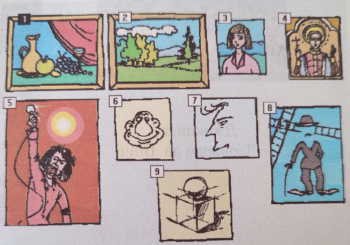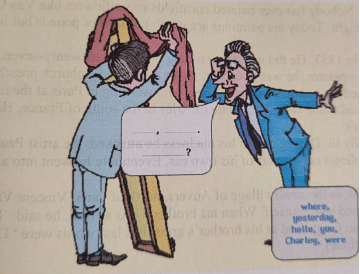Урок "Wonders of Painting".
‘THE WONDERS OF PAINTING’
Objectives:
- to practice students in speaking and listening on the topic;
Learning Outcomes:
By the end of the lesson, students will be able to:
- identify a range of works of art and artists;
- identify the genres in painting and describe pictures;
- make themselves understood in basic communicative situations related to the topic.
Grammar: Conditionals II.
The lesson of developing speaking skills.
Material: a presentation of reproductions of paintings, sculptures and masterpieces of architectural art; recording of musical works; handouts; recording “Bridge to English”
(Intense Educational Ltd Uk), cards depicting paintings by famous artists.
Procedure:
Greeting.
The topic of our lesson is "The Wonders of Painting". We'll talk about art and artists. You will express your feelings and thoughts the art evokes in you. We'll revise and practice the usage of Conditionals II. By the end of the lesson you will be able to make oral reports about your favourite painters and pictures.
Warming-up.
T.: I want to start our lesson with the presentation of pictures . Watch it, admire it, and you will find yourselves in an aura of good, light and kindness. While watching choose the words given in the box which describe everything you see.
(Music by J. Last-Lonesome Shepherd)
(Students are watching a selection of reproductions of famous artists from around the world, sculptures and masterpieces of architectural art)
 reproduction, masterpiece, literature, gallery, painting, cartoon, theatre, architecture, ballet, novel, drama, sculpture, exhibition, pottery, museum
reproduction, masterpiece, literature, gallery, painting, cartoon, theatre, architecture, ballet, novel, drama, sculpture, exhibition, pottery, museum
T: Read the words you have written down.
( Reproduction, masterpiece, painting, architecture, sculpture).
T: Let’s talk about painting, architecture and sculpture - the things which generally come under the heading of the arts .
What are your impressions of the presentation you have seen? How do you understand the proverb 'Art is Power'? Why is Art so powerful? You may use the following expressions:
- I can't help feeling excitement and veneration…
- no one can remain indifferent…
- no wonder…
- no doubt…
- to put all the heart and soul in the work...
- to reflect one's hopes and ideas, sorrows and despair…
- to inspire with noble feelings and thoughts…
- to impress greatly…
- the feelings of pacification and purity…
Elicitation
- I can't help feeling excitement and veneration for these masterpieces created by human beings. It seems to me no one can remain indifferent in the face of such beauty.
- When I see these masterpieces of art the feelings of pacification, purity well up deep into my heart and make it richer. No doubt, Art is Power.
- As for me, art inspires me with noble feelings and thoughts. It gives me a lot of things to think of.
- You see, my dream is to become an architect. I was admiring the pieces of architecture represented here. The old builders put all the heart and soul in their work and it's no wonder that their masterpieces impress everybody greatly.
- I think every artist reflects his hopes and ideas or his sorrows and despair in his works. The masterpieces of art are able to awake the same feelings in people admiring them.
- No unkind feeling can enter your heart when you are in touch with such beauty.
- I was greatly impressed by these masterpieces of art. No doubt, art is like the music. It appeals to our hearts and feelings.
- To my mind, pictures can say something that words are powerless to utter.
I agree with my friend that art is like the music.
- A great painting enriches our experience of life, just as a great poem does or a great composition.
- I can't say that I care for fine arts. I have nothing against it personally, but
- I think teenagers need a different kind of artistic experience As for me, I prefer pop to the classical arts.
The Main Body of the Lesson.
Now, we'll speak about the genres in painting. Match the genre with the picture.
- still-life 6. caricature
- landscape 7. sketch
- portrait 8. collage
- icon 9. drawing
- poster

Speaking. Brain Storming.
Grammar Point. Conditionals II.
If you were an artist what type of genre would you choose and why?
If I were an artist I would……
Role-play. Situation 1.
Imagine the situation. You are in Kyiv and have an opportunity to visit a picture gallery. Act out the situation.
- I'd like to visit the picture gallery. And what about you?
- Oh, I'd gladly go with you. What gallery would you like to visit?
- I'd like to visit the National Art Museum. I've never been there.
- Do you know where it is?
- Certainly. It is 6, Hrushevskyi Street.
- What do they display?
- I don't know. But we can ring them up.
- Hello! Is this the National Art Museum?
- Yes, it is. I'm listening to you. You are displaying Oleksa Novakivskyi, aren't
you?
- Yes, we are. You are welcome.
- Are you open today?
- Yes, we are. We work from 10 a.m to 6 p.m.
- Thank you.
T.: Such painters of Ukrainian origin as Repin, I. Kramskoi, A. Kuindgi, O. Murashko, M. Pymonenko and many others are well-known not only in Ukraine but also all over the world. We should remember T. Shevchenko who devoted most of his pictures to Ukraine and its people and is considered to be the father of modern Ukrainian painting.
Situation 2.
You are in the National Art Gallery and see the pictures of Ukrainian artists. Express the praise or criticism of their paintings. Match the responses.
|
1.- What a still-life. It has such an ungainly look.
2.-Don't you find this picture by M. Pymonenko wonderful?
3.- Are you impressed by this portrait of Kateryna Bilokur?
4.- I'm greatly impressed by the landscapes of T. Yablons'ka.
5. – What a dull picture! There’s no colour in it. |
a. -Oh, yes I'm so excited and interested.
b.-Her landscapes are full of loneliness and sadness.
c. Yes, it's lopsided and crude.
d.- Oh, yes, I'm so excited and interested that any words are powerless to express my feelings... e.-That's a dull picture?! Why, it's beautiful, it's perfect, if it had any more colour it would be wrong.
|
Listening.
T.: Listen to the dialogue. Be ready to unscramble the sentences and put responses
in the correct order. Act out the dialogue.
- Hello, Charley. Where were you yesterday?
- I was at the gallery.
- Was it interesting?
- Yes, I was particularly impressed by one picture.
- Who was the painter?
- It was painted by unknown painter.
- Was it beautiful?
- Yes, it was painted in such a realistic manner!
- What was in the picture?
- A very beautiful woman.
- I would like to see it too.
- Of course, you can see it now. It's mine.
- But the woman in the picture is absolutely naked!
- That is why I was going to buy it.

Students’ Project Presentations:
“My Favourite Painter”, “The Painting I Admire”.
- As I have already mentioned, I like marine landscapes. I admire paintings by I Aivazovskyi, Turner. Joseph Turner (1775-1851) is a famous English painter, whose business was to paint the light. He proved that with the help of light it is possible to show qualities of any subject. We know practically nothing about Turner's life. Son of a London barber, he started drawing and painting when he was a little boy. When Turner was thirteen, he chose the artistic career. In 1802 Turner was elected academician of the Royal Academy, where his oil paintings had been exhibited. He died at the age of seventy-six Turner was a representative of Romanticism. The description of nature dominated in his paintings. In his work with colour he anticipated, in some degree, the practice of impressionists of the 20th Turner's "The Shipwreck". "Burning of the Houses of Parliament" and" Snow Storm" are masterpieces of the great artist. Turner's chief aim in life was to see the sun rise above water he owned a number of houses from: which he could see this happening. And he was particularly fascinated by the line where the sky and the sea join each other.
Turner painted in a style absolutely outside his own time -perhaps the first great artist to do so. Even exhibited pictures like "Rain". "Steam and Speed", "The Fighting Temeraire", "Calois Pier", "Off the Needles", "Sun Rising Through Vapour" have no relation to anything that was being done in Europe, or was to be done for almost a century. He anticipated something of the method and techniques of the French Impressionists who followed Turner's work a generation later.
2. I want to tell you about Van Gogh. Nobody has ever painted cornfields or sunflowers like Van Gogh. His paintings are full of colour and sunlight. Today his paintings are worth millions of pounds but in his lifetime he only sold one.
Van Gogh was born in Holland in 1853. He did not start painting until he was twenty-seven, ten years before he died. Before becoming a painter, he was a teacher, art dealer and a church preacher. In 1886 he left Holland and joined his younger brother. Theo, who was working in Paris at the time. After living there for two years, he moved to the warmer climate of Arles in the south of France. Here he painted some of his most famous pictures However, Van Gogh was mentally ill During one of his madness he attacked, the artist Paul Gauguin. In another fit of madness van Gogh cut off part of his own ear. Eventually he went into a mental hospital but he did not get any better. Finally, on Sunday 27th July 1890, in the small village of Auvers, north of Paris, Vincent Van Gogh took a gun, went into a cornfield and shot himself When his brother Theo arrived, he said: "I hope I did it properly Thirty-six hours later van Gogh died in his brother's arms. His last words were La tristesse durera.' (The sadness will continue).
Сomprehension Task. Answer the questions.
- How many works did Van Gogh sell in his lifetime?
- When did Van Gogh start painting?
- When did Joseph Turner start painting?
- Who was a teacher, art dealer and a church preacher before becoming a painter?
- Whose chief aim in life was to see the sun rise above water?
Wrap Up.
Remember: “A true artist is not one who is inspired but one who inspires others”.
Salvador Dalí
T.: Choose any card with a picture. Write your name on the card. Identify the genre of painting depicted in the picture and write some words to express your feelings and thoughts this picture evokes in you.
Sources:
- навчальна програма “Bridge to English” (Intense Educational Ltd Uk)


про публікацію авторської розробки
Додати розробку
